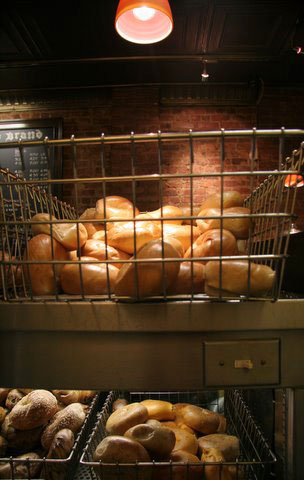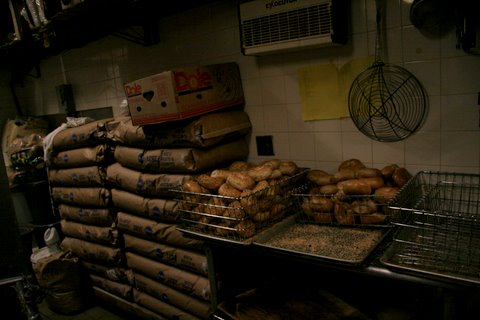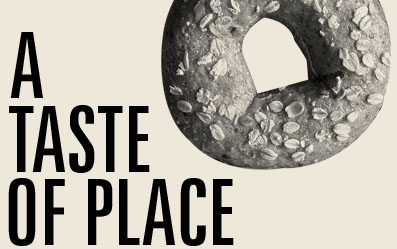Here is a story about bagels. Bagels were first brought to New York by poor Jewish immigrants in the late 19th century. They were street food — cheap and filling.

All photographs by Jamie Feldmar
Over the course of several generations, bagels became less Jewish. They got more popular in markets outside of traditional ethnic enclaves. Other immigrant groups in other cities started mass-producing bagels, and marketed them not as a Jewish food, but as a New York one. Here is the current status of bagels in America: in New York, bagels are still considered a Jewish food. In the rest of America, bagels are seen as a New York food. And internationally, bagels represent America. Why do we associate certain foods with certain places?
For some places, physical structures are representation enough (i.e., the Empire State Building = NYC), but for many others, it is fleeting sensations and memories that describe them best. This is often where food plays a large part. A case study of my own life: Fried clams = childhood vacations to Cape Cod, salty skin, lighthouses, hermit crabs. Ritz crackers = grandparents’ house in Florida, chlorine, loafers. Silver dollar pancakes = home. These are personal memories, highly specific to my own history. But the place/food association sensation is universal. The differences for each person are in the details.
Specific memories, senses, and associations are deeply assigned to certain spaces, but this sensation is highly subjective. The philosopher Yi-Fu Tuan, in his book Space and Place: the Perspective of Experience, writes that when a space feels familiar, it has become a place — but the definition of space and place vary by individual. Beyond that, every individual's personal sense of place is ringed by a haze of mythical space, which is the “fuzzy area of defective knowledge surrounding the empirically known; it frames pragmatic space.” Mythical space is the area with which we are familiar, but weren’t necessarily taught, and it is often too abstract to be illustrated. Facts require contexts in order to have meaning, and contexts invariably grow fuzzy and mythical around the edges. This is where the issue of imagined consumption comes into play.

Mythical spaces for food can be the knowledge that certain regions have certain specialties: think of clam chowder in the Northeast, muffalettas in New Orleans, or deep dish pizza in Chicago.
These are the facts. But then things get hazy: we may not like these foods or ever have eaten them, but our inherent knowledge that they represent a place can convince us of their value. We need not necessarily consume these foods to feel connected to a place — oftentimes, the mere mention of them is enough.
Which brings us back to the bagel, symbol of New York. Traveling often jump-starts a sense of imagined consumption. Travelers want to eat foods representative of the place they are visiting. This is why, when American tourists come to New York, they want a bagel. But what is the motivation? By eating a bagel, can one can shift his or her experience of New York City from a space to a place? The consumption, or the idea of the consumption of these foods can become a physical representation of an intimate experience of place.
A big part of why we travel is not only to participate in new, novel experiences, but also to become a part of older, more established ones. Foods are one of the most tangible manifestations of mythical space. Eating a bagel in New York — or barbecue in Texas, or gumbo in Louisiana — is a way to make that space more familiar; that is, to make them a place.
The Mythical Bagels of NYC
Total time: 2 hours 15 minutes
Active: 35 mins
Adapted from a recipe by Chow.com’s Melissa Wagenberg Lasher
INGREDIENTS:
- 1½ cups tepid water (105°F to 110°F) plus 1 tablespoon for the egg wash
- 1 (¼-ounce) packet active dry yeast (2¼ teaspoons)
- 4 cups bread flour
- 2 tablespoons malt syrup *
- 2 teaspoons kosher salt
- 4 teaspoons granulated sugar
- Sesame seeds, poppy seeds, or coarse salt for topping
PREPARATION
- Place 1½ cups of the tepid water in a bowl and dissolve the yeast completely; set aside. Combine flour, malt syrup, salt, and sugar in the bowl of a stand mixer fitted with a dough hook attachment. Add yeast mixture, scraping any undissolved yeast out of the bowl with a spatula.
- Mix on low until most of the loose flour has been worked into the dough and the dough looks shredded, about 2 minutes. Increase the speed to medium low and continue mixing until the dough is stiff, smooth, and elastic, about 8 to 9 minutes more. (If the dough gets stuck on the hook or splits into 2 pieces, stop the machine, scrape off the hook, and mash the dough back into the bottom of the bowl.) The dough should be dry, not tacky or sticky, and somewhat stiff.
- Shape the dough into a ball, place it in a large oiled bowl, and turn it to coat in oil. Cover the bowl with a damp towel and let the dough rise in a warm place, until it is noticeably puffy and springs back when you poke it, about 20 minutes. (The dough will not double in size.)
- Meanwhile, heat the oven to 425°F and arrange the rack in the middle. Fill a large, wide, shallow pan (3 to 6 quarts) with water and bring to a simmer, not a full boil. Cover until you’re ready to boil the bagels. Line a baking sheet with parchment paper greased with oil or cooking spray. Place a metal rack inside of a second baking sheet and set aside.
- Turn the risen dough out onto a dry surface. Divide the dough into 12 equal pieces, about 3 ounces each. (While you work, keep the dough you’re not handling covered with a damp towel to prevent drying.) Roll each piece into a 9-inch-long rope, lightly moisten the ends with water, overlap the ends by about 1 inch, and press to join so you’ve created a bagel. As necessary, widen the hole in the middle so it is approximately the size of a quarter. Cover the shaped bagels with a damp towel and let rest 10 minutes.
- After resting, stretch the dough to retain the quarter-size hole (the dough will have risen a bit) and boil the bagels 3 or 4 at a time, making sure they have room to bob around. Cook for about 30 seconds on each side until the bagels have a shriveled look, then remove to the baking sheet with the rack in it. Adjust heat as necessary so the water stays at a simmer.
- Sprinkle boiled bagels as desired with poppy seeds, sesame seeds, or coarse salt. Arrange the bagels on the baking sheet lined with parchment paper about 1 inch apart and bake. Rotate the pan after 15 minutes and bake until the bagels are a deep caramel color and have formed a crust on the bottom and top, about 10 minutes more. Remove from the oven and let cool on a rack for at least 30 minutes so the interiors finish cooking and the crusts form a chewy exterior.
Slice bagel in half and top with cream cheese, fried egg and bacon, or smoked fish.
Makes 12 bagels
* Malt syrup can be found in health food stores or online.














